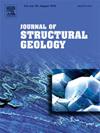Structural heterogeneities in fault-controlled cavity carbonate reservoirs: Insights into fracture and fault patterns
IF 2.6
2区 地球科学
Q2 GEOSCIENCES, MULTIDISCIPLINARY
引用次数: 0
Abstract
This study investigates the role of fault zones and fracture networks in controlling cavity distribution and fluid flow within carbonate rocks of the Tarim Basin using static and dynamic data. By integrating multi-attribute unsupervised seismic facies analysis, fracture network modeling based on ant tracking, and slip and dilation tendency analyses, we construct 3D models to characterize fault zone patterns, cavity distribution, fracture geometry, connectivity, and deformation behavior. The results demonstrate that fault zone patterns are the primary controls on cavity distribution, with cavity arrangements closely reflecting the orientations and densities of fracture networks in the DFN model. Extensive cavity geobodies are concentrated at fault zone intersections, where fractures exhibit increased density and connectivity. The large geobody, defined by considerable connected volumes, high permeability, and high production performance, is situated in these intersections with dense, highly connected fracture networks. These networks enhance fluid flow and shape fluid pathways, highlighting their role in cavity reservoir dynamics. These findings provide insights for improving reservoir modeling and optimizing injection-related geoengineering activities, such as acid stimulation and hydraulic fracturing.
断控洞型碳酸盐岩储层的构造非均质性:裂缝和断层模式的认识
利用静态和动态资料,探讨了塔里木盆地碳酸盐岩内部断裂带和裂缝网络对空腔分布和流体流动的控制作用。通过整合多属性无监督地震相分析、基于蚂蚁跟踪的裂缝网络建模以及滑动和扩张趋势分析,我们构建了三维模型来表征断裂带模式、空腔分布、裂缝几何形状、连通性和变形行为。结果表明,断裂带模式是控制空腔分布的主要因素,空腔的分布与DFN模型中裂缝网络的方向和密度密切相关。广泛的空腔地质体集中在断裂带交叉处,裂缝密度和连通性增加。大型地质体位于这些密集、高度连通的裂缝网络的交叉点上,具有相当大的连通体积、高渗透率和高产能。这些网络增强了流体流动并塑造了流体路径,突出了它们在空腔油藏动力学中的作用。这些发现为改进储层建模和优化与注入相关的地球工程活动(如酸增产和水力压裂)提供了见解。
本文章由计算机程序翻译,如有差异,请以英文原文为准。
求助全文
约1分钟内获得全文
求助全文
来源期刊

Journal of Structural Geology
地学-地球科学综合
CiteScore
6.00
自引率
19.40%
发文量
192
审稿时长
15.7 weeks
期刊介绍:
The Journal of Structural Geology publishes process-oriented investigations about structural geology using appropriate combinations of analog and digital field data, seismic reflection data, satellite-derived data, geometric analysis, kinematic analysis, laboratory experiments, computer visualizations, and analogue or numerical modelling on all scales. Contributions are encouraged to draw perspectives from rheology, rock mechanics, geophysics,metamorphism, sedimentology, petroleum geology, economic geology, geodynamics, planetary geology, tectonics and neotectonics to provide a more powerful understanding of deformation processes and systems. Given the visual nature of the discipline, supplementary materials that portray the data and analysis in 3-D or quasi 3-D manners, including the use of videos, and/or graphical abstracts can significantly strengthen the impact of contributions.
 求助内容:
求助内容: 应助结果提醒方式:
应助结果提醒方式:


